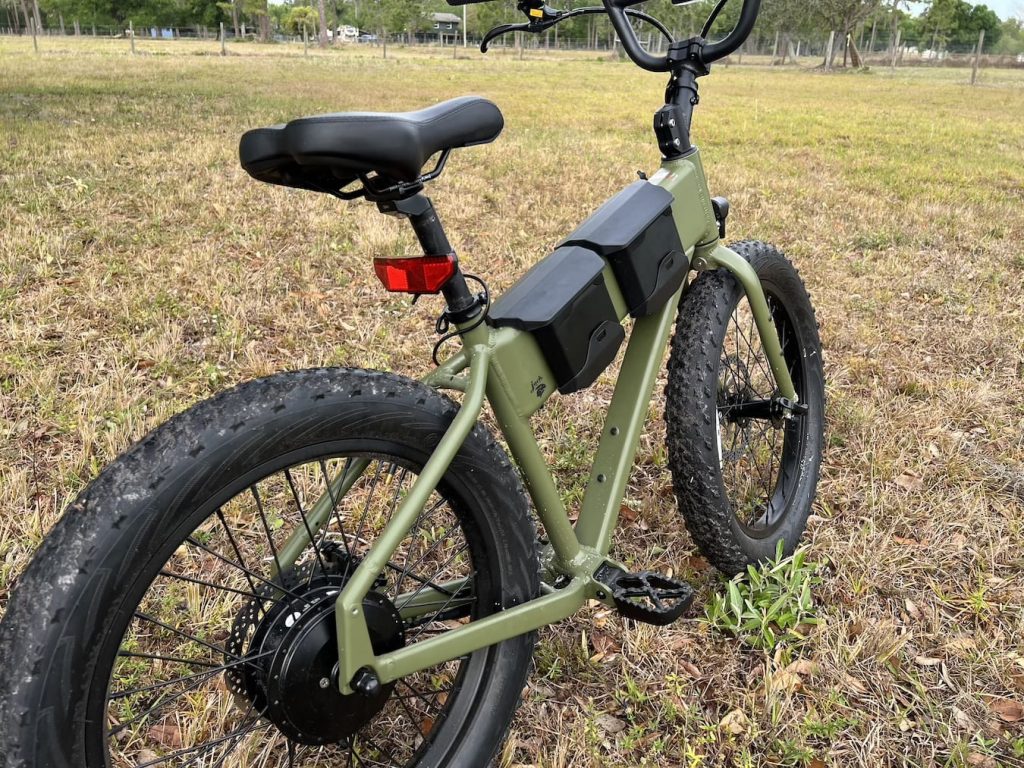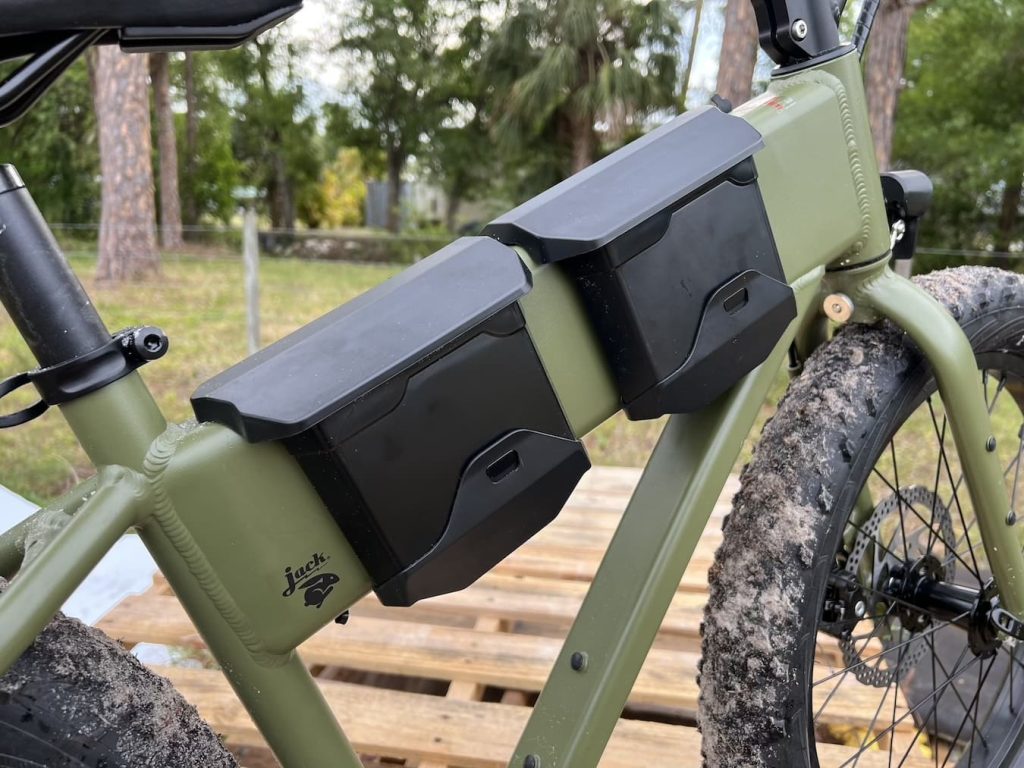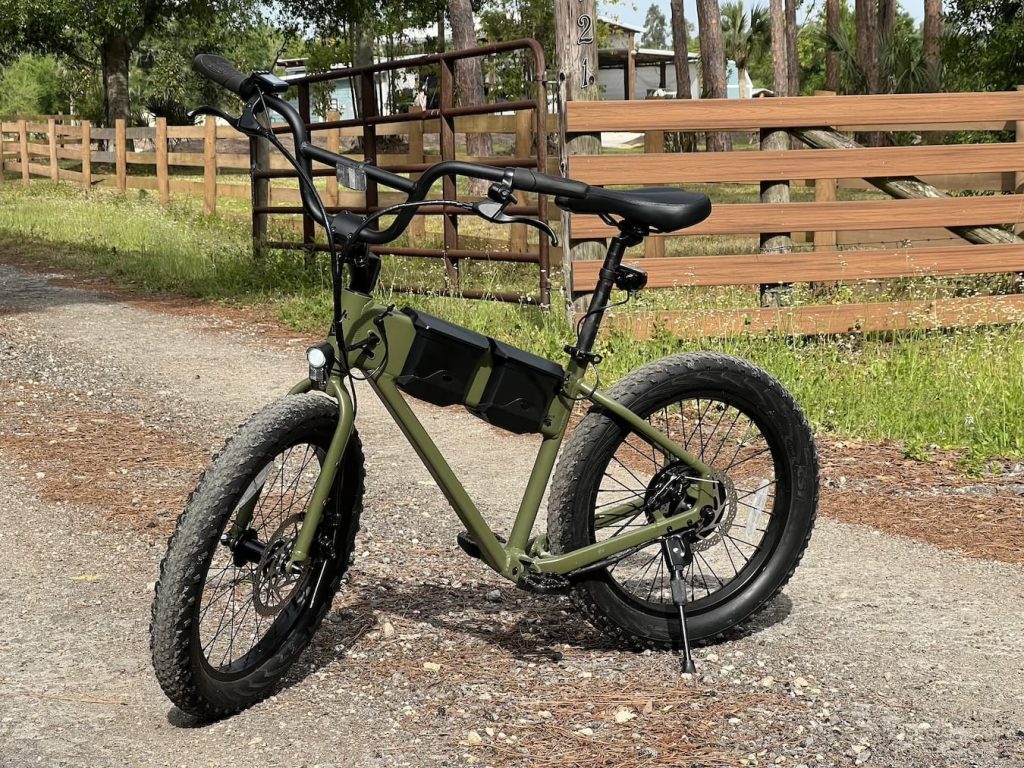We recently covered the launch of the JackRabbit OG2 Pro and XG Pro electric bikes, which added more range and power to the existing micro e-bike lineup from JackRabbit. Having spent a few weeks testing the XG Pro myself, I can attest to just what that means from the perspective of someone with saddle time doing things you wouldn’t have thought possible on a micro e-bike.
To get a sense of what I mean, check out my video review of the JackRabbit XG Pro below.
Or keep reading for my full written thoughts on this fun, high-performance ride stuffed into the body of a much smaller-than-expected micromobility device.
JackRabbit XG Pro video review
JackRabbit XG Pro tech specs
- Motor: 749 geared rear hub motor
- Top speed: 20 mph (32 km/h) – or faster 24 mph (39 km/h) in off-road mode
- Range: 48 miles (77 km)
- Battery: 720 Wh battery (2x 360Wh RangeBuster batteries)
- Max load: 275 lb (125 kg)
- Bike weight: 37 lb (16.7 kg)
- Brakes: Front and rear mechanical disc brakes on 180 mm rotors
- Wheels: 2.8×20″ off-road tires
- Price: $2,249
- Extras: Thumb throttle, 90-degree fold-flat rotatable handlebars (in high-rise format), foldout Mega Metal footpegs, bell, LCD display, kickstand, LED lights that run off the main batteries, plus plenty of optional accessories

What’s new and different?
Don’t forget to check out my article on the launch to see what makes this model so different from the original JackRabbit XG. But to summarize, the XG Pro gets a more powerful motor, larger brakes, high-rise handlebars, wider tires, faster top speed, bigger batteries, and just generally feels like a major upgrade in simply every way.
A lot of those upgrades go a long way towards turning this into a highly competitive bike on more than just convenience. Now, the XG Pro competes on performance as well.
Previously, JackRabbit’s big claim to fame was that its bikes were more convenient. They were smaller and lighter while still offering 20 mph speeds, and that was the big advantage. However, you paid for it with limited range and lower power. Now, however, the JackRabbit XG has massively upgraded the range to over 48 miles (77 km) with the inclusion of not just one but two of JackRabbit’s RangeBuster big-boy batteries. These have nearly 2.5x the capacity of the standard airline-friendly batteries offered by JackRabbit and the resulting range is more than you’d find in many heavier e-bikes with similar battery capacities.

JackRabbit XG Pro: Seriously powerful and torquey
I don’t have a lot of hills to test when I do my riding in Florida, but I can say that the 749W motor will easily wheelie me if I’m not careful (no doubt aided by the short wheelbase), and so the torque is appreciable.
I can also tell you that I towed nearly 100 pounds (45 kg) of kayak and camping gear for around 10 miles, including up sandy berms that might not have been crazy steep but were a serious test of the bike’s ability to climb an off-road grade at slower speeds (i.e. without the benefit of momentum).
So let’s just say that the power and torque are there, and you’re not going to struggle to climb a medium-sized hill.
At the same time, the small footprint and lightweight (for an e-bike) 37-lb design meant that I could strap it to my kayak and take it camping on an uninhabited island that is inaccessible by motorboat. That’s a whole other story, though. Maybe I should write a separate article on that adventure?



The 20 mph (32 km/h) top speed of the previous JackRabbit models also got a boost on the XG Pro up to 24 mph (39 km/h), though only in the new Off-Road Mode. To access this, you can’t simply pop into the display menu and choose the “More speed, please” option. You have to first reach out to JackRabbit and sign a waiver that also includes confirming that you are over 18 and pledge to only use the mode on true closed course, off-road scenarios. From there, you get access to the unlock, which is so convoluted that no one will ever discover it on accident. If you are explicitly told how to do so (which I’m not sure how it won’t eventually leak online), you wouldn’t be able to figure it out from mere button-mashing.
In unlocked mode, the JackRabbit XG Pro’s 24 mph top speed gives higher-performance riders more of what they are looking for, truly unleashing those 749 watts for peak performance.

How well does it ride?
There’s no suspension on the bike (unless you opt for the add-on suspension seat post), but you do get 2.8 inch tires that put more air volume between you and the road. That results in a better ride that isn’t as jarring as you’d expect on a small, non-suspension bike.
If you’re doing actual off-roading, which I highly recommend because of how fun it is on the JackRabbit XG Pro, then you’ll be rising out of the saddle anyway much of the time. In the same way that you drop the seat on the mountain bike because you won’t be using it much of the time anyway, you stand on the pegs and let your bent legs serve as suspension when you approach bigger obstacles.
With the knobbier off-road tires, you also get better grip, though the little bike wants to turn so hard that I am still worried about losing it in a few corners on loose gravel and sand. In my own testing, I covered plenty of different types of terrain, finding grassy fields to be my favorite place to ride the XG Pro. It did fine on gravel and sand too, but the looser terrain also had me feeling a bit squirrely, and the short wheelbase likely contributed to that. But back on grassy pasture to hold the loose soil together, I could fly around at nearly top speed and feel solid.

Who is the JackRabbit XG Pro for?
With its off-road credentials spoken for, I still think the XG Pro has plenty of room left for on-road riding. As a commuter, I can see the XG Pro being a fast, long-range option for a super convenient micromobility device. The included LED lights make it highly visible to other road users at night, and the small size means it can fold up and stow away in an office or apartment.
In fact, I really love the sideways-turning handlebars that spin 90-degrees for even more compact storage. With the bars turned and footpegs folded, the entire bike is a mere 7 inches (18 cm) wide, something you could never claim with an e-bike.
So in my opinion, the XG Pro is great for anyone who wants to enjoy the trails on the same bike they use to get to work or class, and doesn’t have the space in their life for anything bigger. You’ve got to enjoy looking different though, as it’s always going to be a unique and somewhat weird-looking ride compared to what most of us consider a ‘normal’ bike or scooter.

Is it an e-bike?
That brings me to a common question regarding all of the JackRabbits. Are they even truly e-bikes? By definition, probably not. JackRabbits don’t have pedals, instead opting for lighter and more compact foot pegs. That means that the JackRabbit is technically in the class of seated electric scooters.
However, the company refers to it as a micro e-bike, and I’m inclined to agree largely on the basis that it rides and feels like a bike, especially considering that most Americans use their throttles on their e-bikes almost all the time anyway. The pedals on most e-bikes these days are just glorified footrests that have the ability to spin, so JackRabbit basically said, “Enough with the charade,” and took away that rarely used ability.
The fixed footrests on the Jackrabbit remove the bicycle definition, but I can attest to the JackRabbit still feeling like a bike, even if you can’t pedal it. It leans into turns like a bike and feels like a bike when riding over obstacles because it uses a bike’s handlebars and wheels instead of the smaller scooter handlebars and wheels common among scooters.
So much like the Romeo and Juliet cliche, this is basically the rose by any other name situation. It still smells as sweet, and it still rides as good.

Is the JackRabbit XG Pro worth it?
I’ve said this before, and I’ll say it again: If you’re looking for the best dollar-per-watt bargain, then move on. JackRabbit will never be the answer for you. These bikes cost a premium. The XG Pro is the new flagship model and is priced at an eye-watering US $2,249. The OG2’s $1,249 looks downright fiscally responsible by comparison.
But then again, JackRabbit isn’t trying to compete on price. Despite now matching other popular e-bikes on power, speed, and range, it will always be a more expensive alternative due to the company’s unique design that requires them to invest in building their own major components. They don’t benefit from off-the-shelf frames and batteries. Instead, they’ve invested the hard work in engineering new designs, not to mention paying for the tooling to make that happen. You can’t ask for innovation at the price of mediocrity.
For anyone on a budget, there are cheaper ways to get the same speed, power, and range. But there aren’t lighter ways to do it, or more convenient ways, or (in my opinion) cooler-looking ways. And that’s the whole point of JackRabbit. These bikes were originally designed as the perfect solution for college students getting around campus. And after many years and many new models, the company has grown into a fun solution for so many different types of people who share the same basic needs: a small yet potent e-bike-like vehicle for getting around without taking up too much space. Now, everyone from students to professionals ride them, and they’ve become a favorite among RVers, boat owners, private plane pilots, and anyone who needs a super-compact ride.
So in my opinion, the question of whether or not the JackRabbit XG Pro is worth it comes down to whether you want these capabilities in this form factor. You can find it for cheaper, but it’s not going to be as small or lightweight or slick. That’s the magic sauce at JackRabbit, and when you ride it, you damn well feel that magic.
Read the full article here


